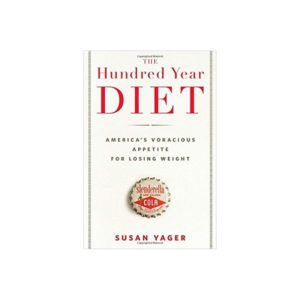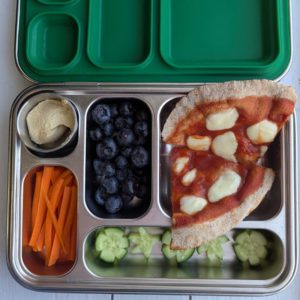
We caught up with Susan Yager to hear her views on dieting and to speak with her about her book, The Hundred Year Diet. The book is a fascinating history of dieting, covering the most influential people, diets and fads. Filled with insightful bits of American history, The Hundred Year Diet will alter your perspective of American eating habits. As you follow through the last 100 years of diet history and nutrition trends you’ll discover that “biggest loser” competitions took place as early as 1920! As nutrition emerged as a new science, anyone could (and did) claim expertise; the resulting characters and diet trends still influence us today. From the discovery of the calorie in the late 1800s to present day dietary guidelines, this book is a gripping adventure not unlike some of the yo-yo diets described within its pages.
It’s amazing to learn that America’s obsession with weight and dieting started over a hundred years ago, at a time when we actually were not overweight as a nation. Now we DO have a serious weight problem. What are the top five changes you see America making towards a healthier approach to foods?
I can tell you the changes I would like to see America make.
- Stop drinking calorically sweetened beverages. In The Hundred Year Diet I call this the 7 percent solution, because each adult in America consumes, on average, about 1 million calories a year, and about 7 percent of those calories come from soft drinks made from sugar-sweetened beverages. For children, the percentage is even higher. Theoretically, giving up sweetened beverages entirely could save an amazing 20 pounds a year.
- To that end, I would like to see calorically sweetened beverages taxed in every state, and taxed high enough to make a difference. The World Health Organization reports that for every 10 percent increase in the cigarette tax, there is a corresponding 4 percent decrease in consumption. Taxing a harmful substance – and calorically sweetened drinks fits my definition – gets results.
- We have got to start eating more fruits and vegetables. The latest Robert Wood Johnson Foundation report (F as in Fat, 2010) lists Vermont as the state that consumes the most fresh produce. And yet, even there, only 17.9 percent of the population reports meeting the USDA requirements of 5+ servings of fruits and vegetables a day. Fruits and vegetables are very expensive and should be subsidized – the tax on soda could help foot the bill. But, fruits have got to be made available to kids in school and at home, and salads and vegetables have got to be a part of school lunch.
- People have to learn how to cook those vegetables at home. Indeed, people have to start taking control back over what they eat, and that can really only be done if they know how to cook. Children should be taught to cook in elementary school, and adults should be taught alongside their kids as after school or evening activities. I can’t believe that we have gotten to a point where this is necessary, but it surely is. Unless we start making it a priority to cook healthy meals at home we will remain a nation where the majority of the population is obese or overweight. Learn more about The Lost Art of Cooking.
- I would like to see Americans learn to respect their food, from the farmers that grow it, to the farm workers that harvest and distribute it, to the pleasure that comes from eating good quality food cooked simply and deliciously at home. We have emphasized low price for so long where our market basket is concerned that we have forgotten that quality counts every bit as much if not more. Needless to say, I would also like to see no money wasted on processed foods. If we look at the obesity rates of countries that have a culture of respect for the quality of their food, we can see what caring can accomplish. For example, the adult obesity rate in both Italy and France is still only at about 10 percent, according to the 2009 OECD Factbook. In Japan, it’s about 3 percent.
As demonstrated in your book, sound, well-balanced nutritional advice is boring! It just doesn’t have the same public appeal as the get-thin-quick fad diets. What advice would you give to someone interested in trying a fad diet?
A fad diet is always a poor idea, because by definition it isn’t sustainable. All fads are just low calorie diets masquerading as magical formulas that somehow, mysteriously, will work better than adjusting ones habits and attitudes towards food. They give a temporary sense of control, and often elation, because severely restricting caloric intake results in weight loss. The problem is that once the person goes off the diet the weight returns, often more than was originally lost, and the disappointment can be devastating. Eventually, the person may become apathetic, and just give up. Right now, more than one third of our adult population is obese, and I have to believe that apathy resulting from years of failed weight loss attempts has a lot to do with it.
What do you think people who are successful at losing (and maintaining weight) have in common?
These are the people who are eating their fruits and vegetables! Not just that, of course, they are balancing their diets to include mostly produce, whole grains, lean fish and poultry, and also allowing themselves to enjoy whatever it is they enjoy the most – pizza, cheese, ice cream, wine – but in limited quantities. The worst thing any dieter can do is make their diet so stringent that it is boring and unpleasant, and to beat themselves up if they eat something they love that they believe to be “bad” for them. Nothing is all that bad, certainly not in moderation, and successful dieters instinctively know this. They also tend to have a built in balance scale – if they are going to eat a larger than normal dinner, they have a smaller than usual lunch. At the end of the week, their caloric intake is pretty much was it was the week before. Perhaps the most important thing of all is that people successful at weight maintenance are physically active. They work out, hike, bike, swim, or just walk a lot – but they keep moving.
Kids today are faced with aggressive advertising campaigns from fast food restaurants and snack food companies. What would your advice be to parents to help combat these influences?
According to the Kaiser Family Foundation, the average child aged 8-12 views 21 food commercials a day! That means 7,600 images of fast food restaurant offerings and candy pretending to be “healthy” breakfast food per year! That is, indeed, tough competition, and to be realistic, a child is going to see these commercials, and demand the products. A parent really has been a parent. That is, say “yes” very occasionally to food of low nutritional value, but say “no” most of the time. This type of food should be a rare treat. The other day I was in the produce section of my supermarket, and I saw a mother shopping with her young daughter. The little girl was pushing a miniature-shopping cart. She put an apple in her basket, and then a banana, discussing the choices with her mom. She was having a great time, learning, and I’m sure feeling very “grown up.” I thought this was one of the best things I had seen in a long time. Kids should be taught how to shop in a supermarket – to walk the outer circle and stay away from the processed foods. And then, a parent should cook alongside the child – teach the child that it can be fun, and easy, to cook the simple, nutritious foods they just bought. I am aware that parents work outside the home, raise their kids, do the chores, and are often exhausted, but there is no way to get around the tremendous benefit of setting a good example by shopping and cooking at home. And, of course, the parent has to be educated in shopping and cooking first.
Today we are seeing more overweight kids, even with healthy weight parents. What are three steps parents can take to promote a healthy weight in their kids without promoting dieting?
- Get them to move more. They should demand adequate time spent on physical education in school, and they should be active with their kids at home, at least on weekends. This can be as simple as taking long walks, or biking in the park. In other words, weather permitting, stress that walking and biking are alternative methods of transportation to the car.
- These are the beverages a kid should drink: water, sparkling water, 1 percent or skim milk. Eliminate sugar-sweetened beverages, including fruit juices.
- Have lots of healthy snacks on hand – fruits, small packages of mixed nuts and dried fruits – and eliminate snacks of low/no nutritional value. The more fresh fruit a kid eats, the better.
Will you share any of your favorite facts/bits of dieting history that didn’t make it into the book?
Dr. Frank McCoy, who ran the McCoy Sanitarium in Santa Monica, California, was an early “diet specialist.” In 1923, he published The Fast Way to Health. McCoy believed that the way to good health was to fast for 1 to several weeks at a time! Here’s what he has to say about this in his book: “The patient has the enjoyment of every pleasure save eating.” McCoy recommended various “fasts” from no food at all, to small amounts of fruits, seaweed, and mineral oil, along with vibrating the fattest parts of the body to “break down fat cells.” He became quite famous, and replaced Dr. Lulu Hunt Peters as the nutrition columnist for the Los Angeles Times after her death in 1927.
I think your book is a great reminder of how we got where we are today and that diet fads are just that: fads (that come and go with little to show for it). Do you think the “quick fix” mindset is here to stay? What do you think can be done to change it?
The really successful fads, the ones like Atkins for example, last because they become remarkably similar to cult indoctrination. That is, they make people believe in the irrational, and tell them not to allow anyone – physician, nutritionist, loved one – talk them out of the diet. That is the “quick fix” you mention, in this case eat all the fat you want as long as you eliminate carbohydrates. Master Cleanse, popular today, is just another version of Frank McCoy’s loopy fasts that I mentioned above. Things will only change with education – nutrition education for our children along with cooking classes. And parents, teachers, and other adults who set a good example, because we all mirror each other and obesity, like any other epidemic, can be caught. We have all got to learn to respect our food and ourselves. Education is really the only ammunition we have to eliminate fads.
What’s the most interesting fad you discovered while working on your book?
I was fascinated by low carbohydrate diets. I think the most confusing and probably worst thing to happen to the American public, in terms of the obesity epidemic, was the original Atkins diet in the early 1970s, because it was so incredibly popular for a long while, and the information was so bad. For the first stage almost no carbohydrates at all were allowed. Complex carbohydrates were vilified alongside sugar and white flour. Even in the later stages of the plan, fruits, vegetables, and whole grains are kept to a minimum, because Atkins claimed that ketosis had to be a permanent state for the diet to succeed. For most people, living with ketosis means no more than 20 to 40 grams of carbohydrates a day; a medium apple has 21 grams. Atkins would come out in a new version every 10 years or so, but didn’t really change. It lives on long after his death, although the latest version is somewhat modified. The whole concept of “low carb,” – eating at the very top of the food chain and eliminating a macronutrient when there are only three of them – the basis of so many weight loss schemes for the past hundred years – still “works” in terms of getting followers. And that is amazing.
For more great books, check out our Recommended Reads!












